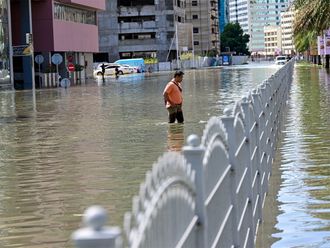Most of the fire accidents reported in Dubai last year were caused by short circuits.
These accidents could have been avoided had people been more careful, said Lieutenant Colonel Mohammed Saleh Beddah, Head of Civil Protection Department.
"Electricity is a safe source of energy when we treat it with respect. If we do not, that is when problems arise," he said.
Short circuits occur during overloading or when two bare wires touch. A circuit is said to be overloaded when too much current flows causing heat build up or wiring to break down. This can lead to sparks and fire.
Lt. Col. Beddah said that electrical circuits in homes are designed so that all components are compatible.
"The size of the wire, outlets and circuit breakers are designed for an anticipated electrical load. Deteriorated insulation is one of the most frequent causes of short circuits," he added.
According to Ghassan Mahmoud Radwan, Fire and Safety Engineer at the Dubai Civil Defence, when a building is under construction, inspectors visit to make sure the electrical system is in compliance with the international building and electrical codes. Only licensed electricians are permitted to install electrical systems, he pointed out.
Most homes have two incoming voltages: 120 volts for lighting and appliance circuits and 240 volts for larger air-conditioning and electric dryer circuits.
When an appliance switch is turned on, electrical current flows through the wire, completing the electrical 'circuit' and causing the appliance to operate. The amount of flowing current is called 'amperage'. Most lighting circuits in the home are 15 amp circuits. Most electric dryers and air conditioners require larger 30 amp circuits.
The amount of electrical power needed to make an appliance operate is called 'wattage' and is a function of the amount of current flowing through the wire (amperage), and the pressure in the system (voltage).
When too many lights or appliances are attached to the electrical system, it will overload and overheat. This can cause the wire insulation to melt and ignite, resulting in an electrical fire. The amount of electrical current flowing through wire is affected by resistance. This is known as 'ohms'. Resistance causes increased heat in the wire.
A 'circuit breaker' or 'fuse' is a safety device designed to prevent accidental overloading of electrical circuits, said Radwan. They are set at a specific amperage. When that amperage is exceeded, it trips and shuts off the flow of electricity, stopping the circuit from continued overheating. When a fuse or circuit breaker trips, it is important to find the cause and correct it. Often, people will just reset the breaker or put in larger fuse. Never do this as it could cause a fire, warned Radwan.
The potential for electrical shock or fire from an electrical appliance is very real, especially when safety recommendations are not followed.
"When choosing an electrical appliance, be sure it is approved by a safety-testing laboratory. This insures that it has been constructed in accordance with accepted electrical standards and has been evaluated for safety," said Radwan. Use the appliance only according to manufacturer's specific instructions.
Disconnect immediately if an appliance blows a fuse, trips a breaker or gives off sparks or sizzling sounds, said Radwan. Discard the appliance or have it repaired.
Never place appliance cords where they will come into contact with the stove or other heated surfaces. Unplug all non-essential electrical appliances when not in use.
Use only correct-size fuses and breakers for circuits. Size refers to a circuit's amperage rating. If you don't know the rating, ask an electrician to identify and label them.
Radwan said that when using an extension cord, be sure it is designed to carry the intended load. Most cannot carry as much current as permanent wiring and tend to overheat.
Do not use an extension cord in place of permanent wiring, especially if a tripping hazard exists or where there is high physical abuse, such as under a carpet. The cord must be protected from damage. Do not run it around objects or hang on a nail. Inspect it periodically for worn insulation and overall condition.
Keep heaters, stoves, irons and other heat-producing appliances away from furniture, curtains, bedding or towels. Also, give televisions, stereos and computers plenty of air-space so they will not overheat.
Never use an appliance with a damaged cord, and be sure to use three-pronged electrical devices in three-pronged outlets. Keep electrical cords out of the path of traffic. If you put cords under carpets or rugs, wires can be damaged and might result in fire.
An electrical cord should never be wrapped around an appliance until the appliance has cooled. Because hair care equipment is often used in bathrooms near sinks and bathtubs, it is extremely important to be especially careful that the appliances do not come in contact with water. If one drops into water, do not touch it until you have pulled the wall plug. If you touch an electrical appliance, wall switch or electrical cord while you are wet or standing in water, it will increase the chance of electrical shock.
Never put a kitchen knife or other metal object in a toaster to remove stuck bread unless it is unplugged and cooled.
Inspect appliances regularly to make sure they operate properly. If an appliance smells funny when in use, makes unusual sounds or the cord feels warm to touch, repair or replace the unit. Do not repair it yourself unless you are qualified. Keep appliances in a cool, dry place to prevent rusting.
When an electrical emergency occurs, there are several survival actions that can be taken. You should know how to trip the main circuit breaker at the electrical panel to turn off all power to the house.
If an appliance smells funny or operates improperly, pull the plug if it can be done safely. If burning or smoking from an appliance occurs, turn off the power at the circuit breaker.
Never put your finger or anything other than an electrical plug in an outlet. Have any loose-fitting plugs fixed by an electrician. Do not force a plug into an outlet if it will not fit.
Replace broken plates on outlets and switches so that no wiring is exposed. Use safety covers on all outlets accessible to children. Make sure the amperage rating for an extension cord is greater than, or equal to, the tool you will be using.
Inspect all cords and wiring on a regular basis for broken or frayed insulation. Immediately repair or replace unsafe cords. Do not place electric cords so they run through doorways, windows, or under carpets. Always allow the cord to have some slack as a cord pulled too tightly can put tension on plugs and receptacles and increase the potential for connections to pull loose.
Pay attention to avoid any situation which might cut the insulation on a cord, exposing bare wiring or causing it to overheat.
Pull by the plug not the cord when unplugging an appliance. Do not staple or nail cords or wiring to walls or floors.
Never touch a wire lying
Short circuits main cause of fires
Most of the fire accidents reported in Dubai last year were caused by short circuits.












